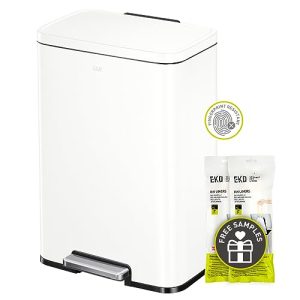Have you ever stood in your kitchen, staring at your blender, unsure where to start? Using a kitchen blender might seem simple, but mastering it can unlock endless possibilities for your meals and drinks.
Whether you want to whip up smoothies, sauces, or soups, knowing the right techniques will save you time and effort. In this guide, you’ll discover easy steps and insider tips to make your blender work perfectly every time. Ready to turn your blender into your new favorite kitchen tool?
Let’s dive in.
Choosing The Right Blender
Choosing the right blender makes cooking easier and faster. It helps you prepare smoothies, soups, sauces, and more. Picking a blender that fits your needs saves time and effort. Consider the types, features, power, and capacity before buying.
Types Of Blenders
There are several types of blenders for different uses. Countertop blenders are popular for daily kitchen tasks. They handle fruits, vegetables, and ice well. Personal blenders are smaller and good for single servings. Immersion blenders are handheld and great for soups and sauces. High-performance blenders can crush tough ingredients and make smooth textures.
Features To Look For
Choose blenders with easy-to-use controls. Multiple speed settings give better blending results. Pulse function helps control blending time. Look for durable blades made from stainless steel. A blender with a secure lid prevents spills. Dishwasher-safe parts make cleaning simple. Some blenders have preset programs for specific recipes.
Power And Capacity
Power affects blending speed and smoothness. Higher wattage blends tougher ingredients faster. For daily use, 500 to 700 watts is enough. Larger capacity jars suit big families or batch cooking. Smaller jars save space and fit single servings. Match the capacity to your usual cooking needs.
Preparing Ingredients
Preparing your ingredients properly can make a huge difference in how smoothly your blending process goes. It affects the texture, the flavor, and even how long your blender runs. Taking a few extra minutes to get everything ready can save you from frustrating clogs or uneven blends.
Chopping And Portioning
Start by cutting your ingredients into smaller pieces, roughly the size of a walnut or smaller. This helps your blender blades work efficiently without overloading the motor.
For example, if you’re blending a smoothie, chop fruits and vegetables into chunks rather than tossing in large whole pieces. It also helps to portion your ingredients based on your blender’s capacity—don’t fill it to the brim.
Have you noticed your blender struggling or making a loud noise? That’s often because the pieces are too big or packed too tightly.
Choosing The Right Liquids
Liquids help create movement inside the blender, allowing the blades to circulate ingredients evenly. Water, milk, broth, or juice can be used depending on your recipe.
Think about how thick or thin you want your final blend. Adding just a splash of liquid at first lets you control the consistency better than dumping it all in at once.
Do you prefer creamy smoothies or light soups? The type and amount of liquid you add will make all the difference.
Order Of Ingredients
Placing ingredients in the right order affects how well they mix. Start with liquids at the bottom, then soft fruits or vegetables, and finish with hard or frozen items on top.
This layering prevents your blender from getting stuck and helps everything move toward the blades smoothly. It’s a simple trick I learned after struggling with a stubborn frozen fruit smoothie.
Next time you blend, try arranging your ingredients thoughtfully. How does changing the order affect your blend’s texture?
Blending Techniques
Blending techniques help create smooth textures for soups, smoothies, and sauces. Use short bursts to control consistency and avoid over-blending. Experiment with speed settings for best results.
Blending Techniques are crucial for making the most of your kitchen blender. Understanding different techniques enhances your blending experience. It helps achieve the desired texture and consistency. Let’s explore some basic but effective methods.Starting With Low Speed
Begin with a low speed to prevent splattering. It helps in mixing ingredients evenly without creating air pockets. Gradually increase the speed to blend tougher ingredients smoothly. This approach ensures that the contents are mixed thoroughly.Using Pulse Mode
The pulse mode provides better control over the blending process. It is ideal for chopping or mixing ingredients quickly. Use short bursts to break down items without over-processing them. This mode is perfect for chunky textures like salsa or soup.Achieving Smooth Texture
For a silky texture, blend at high speed until smooth. Add liquid slowly to maintain the right consistency. Stop occasionally to scrape down the sides for even blending. This technique is essential for smoothies or creamy soups.Cleaning And Maintenance
Cleaning and maintaining your kitchen blender keeps it working well and safe for food. Regular care stops bad smells and clogs. A clean blender lasts longer and blends better. Follow simple steps to keep your blender fresh and sharp.
Quick Cleaning Tips
- Rinse the blender jar right after use to stop food from drying.
- Add warm water and a drop of dish soap into the jar.
- Run the blender for 20-30 seconds to clean inside.
- Rinse the jar and lid with clean water.
- Dry all parts with a clean towel before storing.
Deep Cleaning Methods
For tough stains and smells, try deep cleaning your blender.
- Mix equal parts water and white vinegar in the jar.
- Let it soak for 15-20 minutes to break down residue.
- Use a soft brush or sponge to scrub the jar and lid.
- Rinse thoroughly to remove vinegar smell.
- Occasionally clean the blender base with a damp cloth, avoiding water inside.
Blade Care And Safety
- Always unplug the blender before cleaning blades.
- Handle blades carefully to avoid cuts.
- Remove blades for thorough cleaning if your model allows.
- Dry blades completely to prevent rust.
- Check blades regularly for dullness or damage and replace if needed.
Troubleshooting Common Issues
Troubleshooting your kitchen blender can save you time and frustration. Many common issues are simple to fix once you know what to look for. Understanding these problems helps you get the best performance from your blender every time you use it.
Overheating Problems
Has your blender stopped working after a few seconds of use? This might be due to overheating. Blenders can get too hot if you blend thick mixtures or run the motor continuously for a long time.
To prevent overheating, try blending in short bursts. Give your blender a break between uses to cool down the motor. Also, check if the vents are clear of dust or food debris, as blocked airflow can cause heat buildup.
Uneven Blends
Do you notice chunks or uneven textures in your smoothies or sauces? This is usually because the ingredients aren’t moving properly inside the jar. Overloading the blender or using too little liquid can cause this problem.
Try adding more liquid to help the blades move ingredients smoothly. Stop the blender and stir the mixture halfway through blending. This simple step can make a big difference in the texture.
Noise And Vibrations
Is your blender louder than usual or shaking violently during use? This might signal a loose blade assembly or an unbalanced container. Sometimes, small stones or hard pieces in frozen fruit can cause extra noise too.
Make sure the blender jar is seated correctly on the base. Tighten the blade assembly if it feels loose. If the noise continues, check the ingredients to remove any hard objects that could be causing damage.
Creative Blender Recipes
Blenders are not just for simple mixing. They help create many tasty dishes with ease. Using a blender opens up many creative cooking options. It can make your meals faster and more fun. From drinks to snacks, a blender handles them all well.
Smoothies And Shakes
Smoothies and shakes are quick and healthy. You can blend fruits, yogurt, and ice for a fresh drink. Add spinach or kale for extra nutrition. Use milk or juice to change the flavor. Sweeten with honey or a banana. Protein powder or nuts make it filling. Blend until smooth and enjoy a fresh treat.
Soups And Sauces
Blenders make soups creamy without cream. Cook vegetables, then blend for a smooth texture. Use broth or water to thin the soup. Sauces also blend well, like tomato or pesto. Mix herbs, garlic, and oil for a fresh sauce. A blender saves time and makes mixing easy. Heat soup after blending for a warm meal.
Nut Butters And Dips
Blenders turn nuts into creamy butters quickly. Use almonds, peanuts, or cashews. Blend nuts until smooth, adding oil if needed. Make dips like hummus by blending chickpeas, tahini, and lemon. Add spices or herbs for taste. Fresh dips and butters are tasty and healthy snacks. Perfect for spreading or dipping veggies.
Frequently Asked Questions
How Do I Safely Use A Kitchen Blender?
Always secure the lid before blending to avoid spills. Start at low speed, then gradually increase. Avoid overfilling the jar. Never insert utensils while the blender is running to prevent injuries.
What Ingredients Can I Blend In A Kitchen Blender?
You can blend fruits, vegetables, nuts, ice, and liquids. It’s ideal for smoothies, sauces, soups, and purees. Avoid very hot ingredients to prevent damage or splattering.
How Do I Clean My Kitchen Blender Effectively?
Rinse the jar immediately after use. Blend warm soapy water for quick cleaning. Disassemble removable parts and wash them separately. Dry thoroughly before reassembling to prevent mold.
Can A Kitchen Blender Crush Ice Efficiently?
Most kitchen blenders can crush ice if they have a powerful motor. Use the pulse function to avoid overheating. Crushing ice helps create smooth drinks like frozen cocktails or smoothies.
Conclusion
Using a kitchen blender makes cooking faster and easier. You can blend smoothies, soups, and sauces in seconds. Always follow safety tips for the best results. Clean the blender right after use to keep it working well. Experiment with different ingredients to find your favorite recipes.
A blender is a handy tool in any kitchen. Give it a try and enjoy fresh, homemade food every day.

Sophie Hartwell is the founder of KitchenQuik.com, where she shares kitchen tips, smart cooking hacks, and the best product picks to make everyday cooking easier and more enjoyable.




